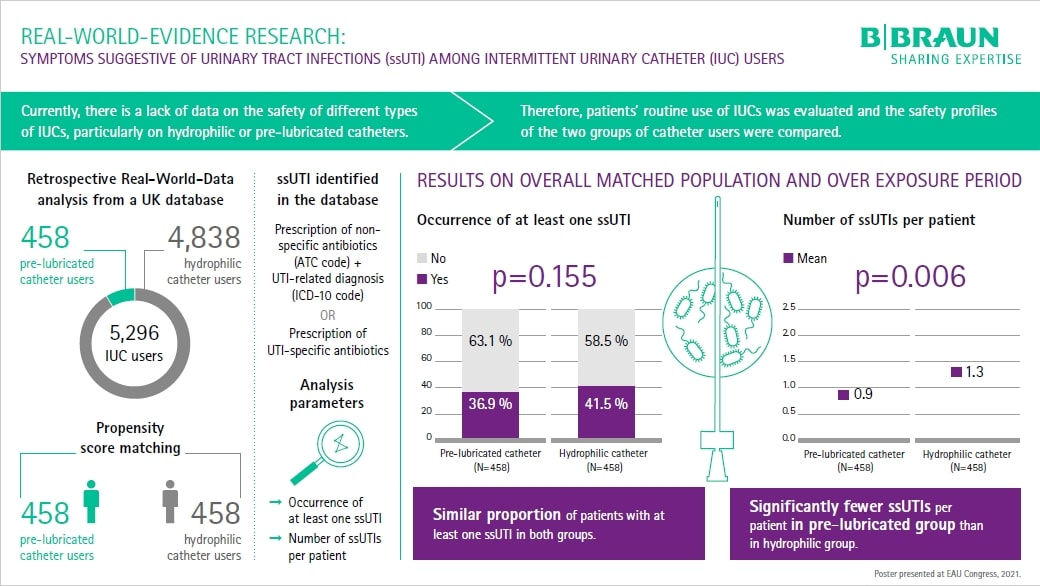You have successfully logged out.
Not registered yet?
Intermittent urinary catheterisation
Urinary tract infection - a common burden[1]
Urinary tract infection (UTI) is the most important complication of patients using intermittent urinary catheterisation but also other complications can impact patients' overall health and their quality of life.[2,3]

Medical Professional
This information is meant for medical professionals only. Please confirm that you are a medical professional before accessing the information.
Confirm Yes, I am a health care professional. Cancel No, I am not a health care professional.The emotional and practical burden of intermittent catheterisation and UTIs is considerable in the patients’ lives.[3] UTIs account for about 23 to 63 percent of the total lifetime costs for spinal cord injury patients practicing intermittent catheterisation.[4] Very important are good education of all involved in IC, good patient compliance, the use of proper material and the application of a good catheterisation technique.[2]
UTIs related to intermittent catheterisation can have negative consequences such as:
- High morbidity and frequent hospitalisations[4]
- Risk of developing dangerous resistance to antibiotics[2]
- Economic burden[4] for the healthcare system
Recurrent urinary tract infections often lead to repeated use of antibiotics and thus can accelerate the development of antibiotic resistance and persistance.[5]
It is therefore very important to reduce the risks of UTIs in patients as much as possible.
Real-World Evidence
Research into ssUTIs in users of intermittent urinary catheters
We funded the first Real-World Evidence of intermittent catheterisation to compare the effects of pre-lubricated and hydrophilic catheters on the incidence of symptoms suggestive of urinary tract infections (ssUTIs).[6]
A patient database compiled by a representative panel of 1,950 general practitioners and 2,950,381 active patients in the UK was used for this longitudinal, observational study. This database considered 5,296 people using catheters.
Outcome of the study
Most importantly, the study showed significant results indicating a lower incidence of ssUTIs when pre-lubricated catheters were used:[6]
- The number of ssUTIs per affected patient was significantly lower when pre-lubricated instead of hydrophilic catheters were used, particularly in the groups of female users, prevalent patients and in the subgroup of 18 to 50 years.
- The proportion of patients with one or more ssUTIs in the study period was lower when pre-lubricated catheters instead of hydrophilic catheters were used.
- In the subgroup of patients who did not switch between catheter types during the study, the so called "continuous use" patient group, the proportion of patients with at least one ssUTI was even 20.9 percent lower when pre-lubricated instead of hydrophilic catheters where used.
 Study design and extract of its outcome, modified by B. Braun for the EAU congress 2021.
Study design and extract of its outcome, modified by B. Braun for the EAU congress 2021.
Authors and acceptance of the study
Professor Chapple (Royal Hallamshire Hospital, Department of Urology, Sheffield, United Kingdom), Professor Chartier Kastler (Sorbonne University, Department of Urology, Paris, France) and Professor Schurch (Vaudois University Hospital of Lausanne, Department of Clinical Neurosciences, Lausanne, Switzerland) participated in and supported this study which was accepted by three different congresses:
- European Association of Urology (EAU) 8 -12 July 2021; Author: Prof. Emmanuel Chartier-Kastler
- ISCoS, Canada, Vancouver, 29 Sept -2 Oct 2021; Author: Prof. Emmanuel Chartier-Kastler
- ICS, Australia, Melbourne, 14 -17 Oct 2021; Author: Prof. Emmanuel Chartier-Kastler; Speaker: Prof. Chapple
What is Real-World Evidence (RWE) and Real-World Data (RWD)?
Real-World Evidence (RWE) and randomized control trial (RCT) data are considered mutually complementary and a most powerful resource in evidence-based medicine.
Real-World Evidence (RWE) is the clinical evidence regarding the usage and potential benefits or risks of a medical product derived from analysis of Real-World Data (RWD).
Real-World Data (RWD) are data relating to patient health status and/or the delivery of health care routinely collected from a variety of sources. Examples of RWD include:
- Data derived from electronic health records (EHRs), claims and billing data
- Data from product and disease registries
- Patient-generated data including in home-use settings
- Data gathered from other sources that can inform on health status, such as mobile devices
[1] Öztürk R, Murt A. Epidemiology of urological infections: a global burden. World J Urol. 2020 Nov;38(11):2669-2679. doi: 10.1007/s00345-019-03071-4. Epub 2020 Jan 10. PMID: 31925549.
[2] Wyndaele JJ. Complications of intermittent catheterization: their prevention and treatment. Spinal Cord. 2002 Oct;40(10):536-41. doi: 10.1038/sj.sc.3101348. PMID: 12235537
[3] Fumincelli L, Mazzo A, Martins JCA, Henriques FMD, Cardoso D, Rodrigues MA. Quality of Life of Intermittent Urinary Catheterization Users and Their Caregivers: A Scoping Review. Worldviews Evid Based Nurs. 2017 Aug;14(4):324-333. doi: 10.1111/wvn.12231. PMID: 28742287.7.
[4] Rognoni C, Tarricone R. Healthcare resource consumption for intermittent urinary catheterisation: cost-effectiveness of hydrophilic catheters and budget impact analyses. BMJ Open. 2017 Jan 17;7(1):e012360. doi: 10.1136/bmjopen-2016-012360. PMID: 28096251; PMCID: PMC5253566.
[5] Huemer M, Mairpady Shambat S, Brugger SD, Zinkernagel AS. Antibiotic resistance and persistence-Implications for human health and treatment perspectives. EMBO Rep. 2020 Dec 3;21(12):e51034. doi: 10.15252/embr.202051034. Epub 2020 Dec 8. PMID: 33400359; PMCID: PMC7726816.
[6] Chartier-Kastler E, Chapple C, Schurch B, Saad M. A Real-world data analysis of intermittent catheterization, showing the impact of prelubricated versus hydrophilic catheter use on the occurrence of symptoms suggestive of urinary tract infections. Eur Urol Open Sci. 2022 Mar 4;38:79-87. doi: 10.1016/j.euros.2022.02.008. PMID: 35495281; PMCID: PMC9051966.

